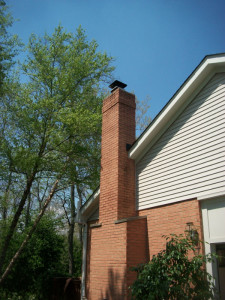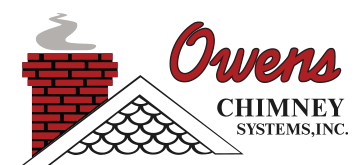If you’re like most homeowners, your chimney is probably one of the most taken-for-granted parts of your home. It’s one of those things that you expect to be there for you when you need it but may not give it much thought in the meantime. “It’s all just cosmetic,” we think; this thought process isn’t one to be ashamed of, however, it is one to be corrected sooner rather than later. Monitoring your chimney for leaks regularly will help save you from large repair bills down the road.
 Chimney Flashing is Nothing to Overlook
Chimney Flashing is Nothing to Overlook
If you look at your chimney from the outside, you will notice that there are metal strips around the base of the chimney, right where it meets the roof. Because that is an especially vulnerable spot on a roof, a spot where precipitation can easily leak in, these metal strips are layered to cover the junction and help water flow away from the intersection. Those strips are called the flashing. The problem is, flashing can get torn or ripped during high winds, or can come loose from the house. If this happens, rain can easily make its way into your home, causing your ceiling and walls to weaken and sag over time. Chimneys are notorious for leaking, and the problem is almost always the flashing, which lies at the point where the chimney rises above the roof. It keeps water out of your chimney, protecting both the flue and roof. Flashings are available in a variety of materials. You’ll want to have new chimney flashing installed if you find that it’s missing, rusted through, falling out or completely covered with roofing tar, which is a common short-term fix that’s sure to be hiding a bigger problem underneath.
Chimney Materials Contribute to Deterioration
The mortar used in the construction of your chimney is exposed to the elements on the outside and the heat from your firebox on the inside. This greatly speeds up the weathering process. Chimney materials—brick and mortar—are, by their very nature, porous. As such, they experience hastened deterioration as a result of prolonged exposure to and contact with water and the elements. The freezing and thawing process—during which time water that has penetrated the various chimney materials freezes and expands—quickly deteriorates the overall construction of your chimney.
Signs of a Chimney Leak
There are many different places that might be leaking around your chimney, and we can help you find those problem areas in a hurry. As a homeowner, there are signs you can be looking for if you suspect a leaky chimney. One of the first things you might notice is stained ceiling paper near your fireplace. If you see this, it’s a pretty good bet that something is leaking around the chimney. Chances are, your flashing is loose.
The Weather is Your Chimney’s Nemesis
Now that colder weather is here, a big cause of chimney damage is the freeze-thaw cycle. Mortar is a porous material, and when precipitation falls, it gets into the pores and sets there. When the weather freezes, that precipitation freezes and expands, causing those pores to expand as well. This gives more room for more precipitation, and the cycle continues until the very structure of your chimney is damaged. This can cause leaks to occur.
One way to limit the impact the freeze-thaw cycle has on your chimney is to prevent as much water as possible from penetrating the materials as possible. Water in your chimney can also cause rust on steel and cast iron parts, ultimately weakening or destroying them over time. The weather is constantly battering the exterior of your chimney. Harsh weather conditions can have a negative effect on your chimney.
Consider Waterproofing Your Chimney
By waterproofing your chimney, you enable it to repel up to 99.9% of the water that would otherwise penetrate the brick and/or other materials. Waterproofing is a true preventative measure that can add years to your chimney’s life. Because it’s not a requirement, many homeowners deprioritize it; this is a big mistake! There are many issues that can develop as a result of water being on and getting in to your chimney, and, as such, swift and immediate action should be taken to ensure that you’re not faced with unnecessary and avoidable repairs bills.
Water doesn’t evaporate as quickly during the colder months, which affords it more time to wreak absolute havoc on your chimney. Unless you’re just looking for a reason to get rid of your chimney, there really is no excuse for not taking better care of it. It’s time to have an experienced technician inspect your chimney, have it repaired if necessary, and have it coated with a waterproofing product to prevent any future water penetration issues. Whether you have a leaky chimney or are simply looking to prevent leaks before they happen, call Owens Chimney Systems today!
